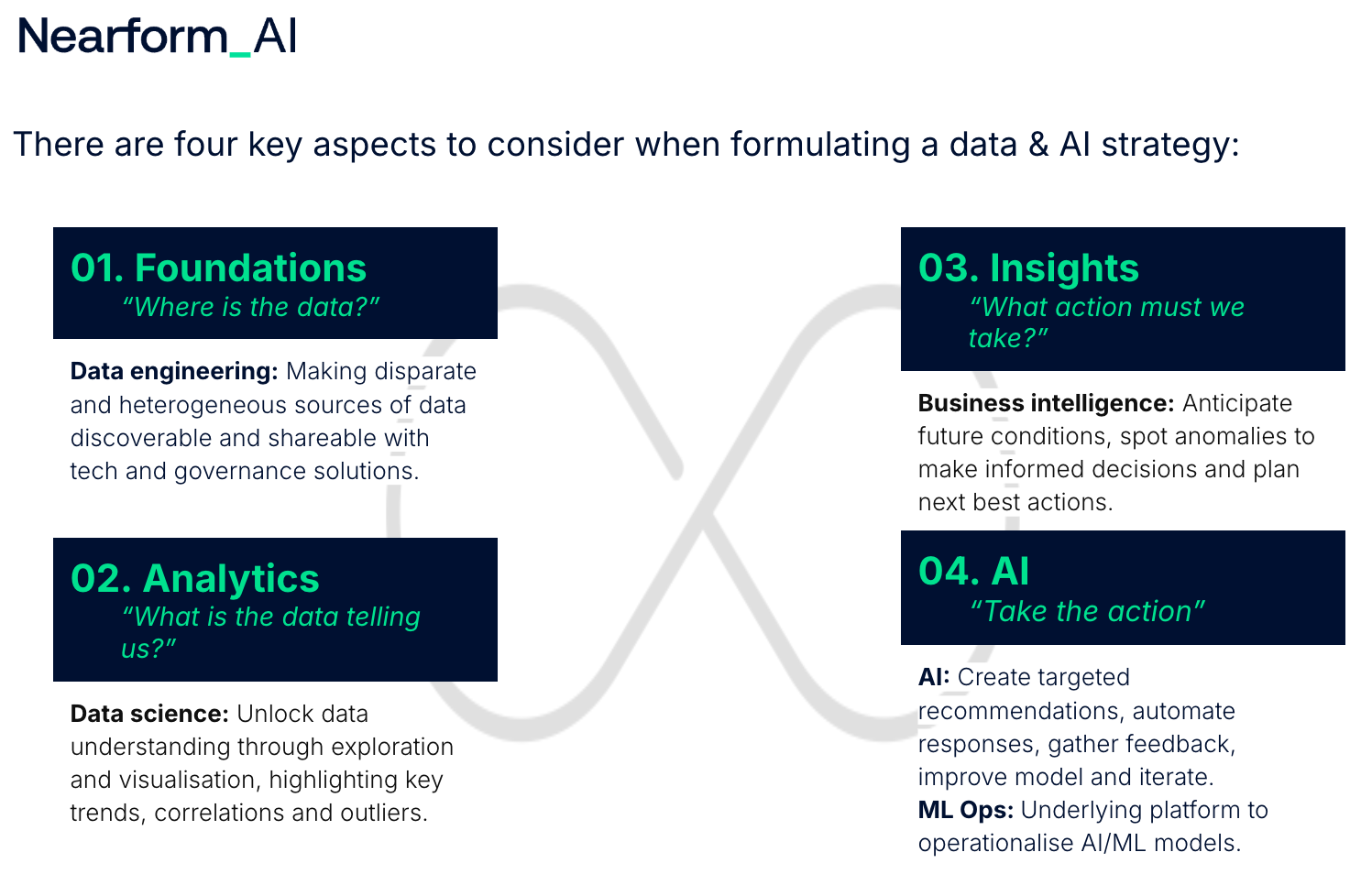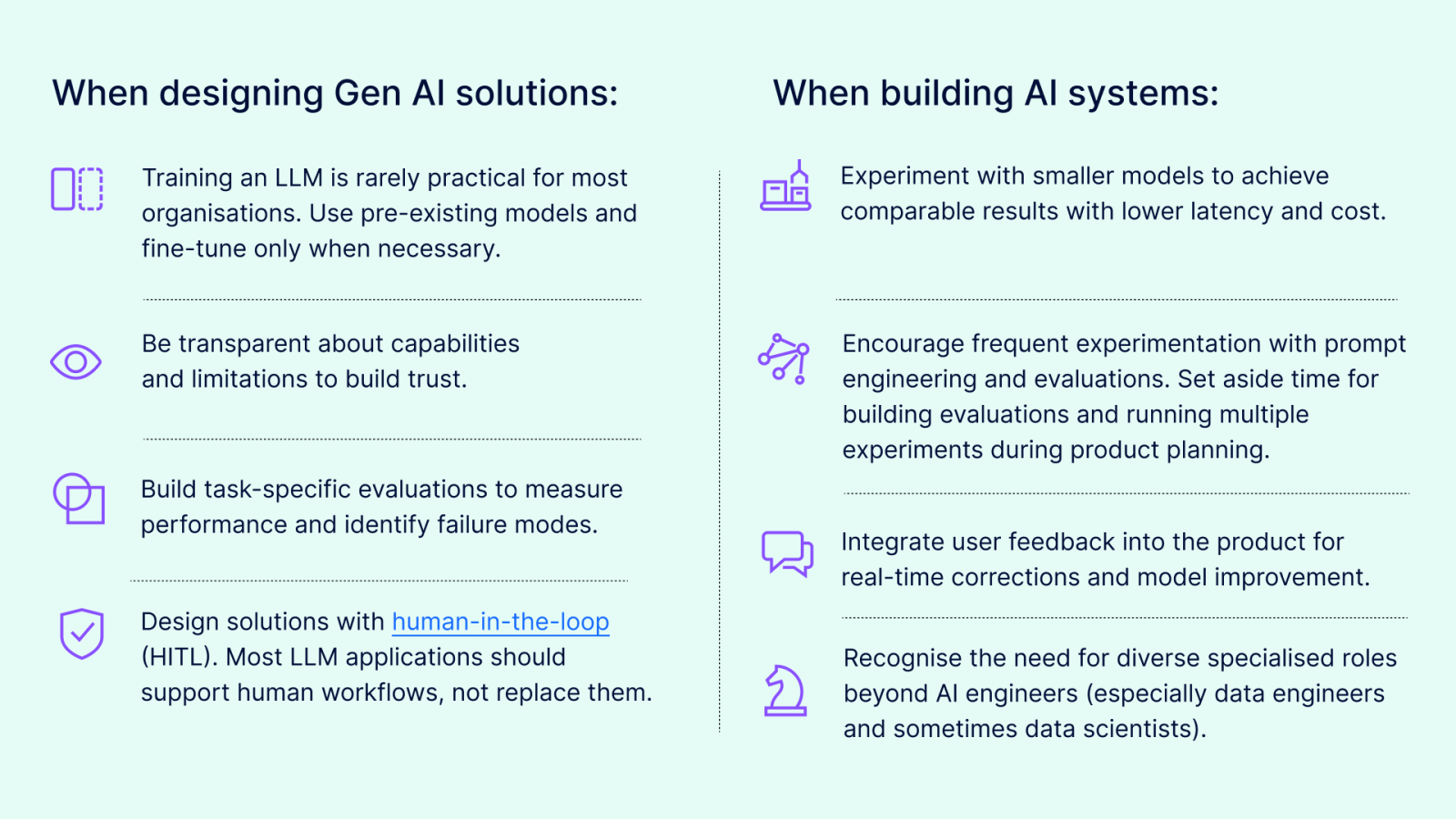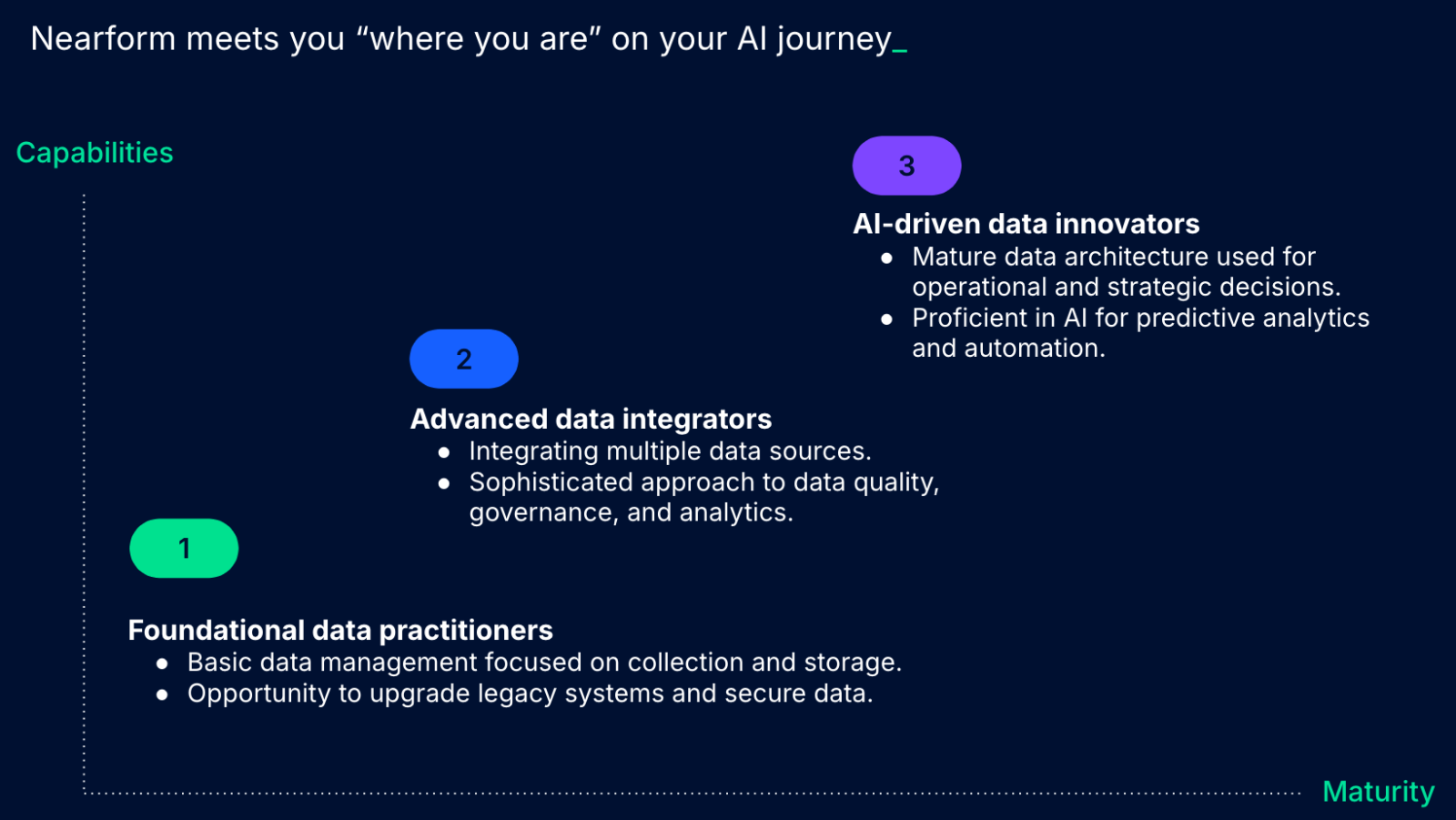Maximising AI’s business impact: Turning talk into action and experience into success
Identifying where the biggest impact can be made with the least difficulty to yield positive business results from your AI projects
For all of the promise of artificial intelligence (AI) technology, there’s also frustration around how to maximise its value today. Nearform Solutions Principal Cian Clarke says, “There’s a lot of executive pressure on folks to do something in the space. But starting an AI project just because of pressure can yield bad results.”
The pressure to explore the power of AI is understandable, because companies that are successfully integrating it into their processes and systems are developing a competitive advantage over those that aren’t. One survey found that 87% of global organisations believe that AI technologies will give them a competitive edge.
Maximising the chances that the time and money spent on an AI project will yield real, sustainable positive business results starts with asking specific questions, and getting consensus from cross-functional partners.
| Nearform expert insight: | “Sometimes there’s something that seems like a really cool solution. But we have to remember, this might not actually be valuable for this particular situation. There’s a risk of focusing your energy somewhere that isn’t giving you the best value. That’s why we think in terms of a ‘big picture’ view. From there we help to narrow down to a few really good choices, then apply whatever applicable constraints, and choose one or more that everybody’s happy with.” Shaun Anderson, Field CTO, Nearform |
With research organisations such as Gartner stating that “AI services will be the dominant growth driver in the IT services market"* it’s no surprise that tech leaders are driven to make sure their organisations aren’t left behind. To maintain competitiveness, it is important for many companies to find ways to integrate this promising new tool into their systems. Unfortunately, when the process is rushed or not thought through correctly, many projects take up time and capital, and fail without delivering the desired transformative results.
There are clear ways to avoid the potential pitfalls and quickly take an experimental, iterative approach to finding, then deploying, AI solutions that solve business challenges.
| Expert insight: | “AI project failure is 99% about expectations. It’s not about the failure of the technology but the expectation of what people believe the technology can do.” Carm Taglienti, Executive-level technology leader |
| By the numbers: | - $154 Billion: Worldwide spending on AI-centric systems across all industries in 2023 - $443 Billion: Total worldwide market for AI services by 2027 with a 16.9% five-year CAGR* - Up to 80% of AI projects are considered failures |
Avoiding “shiny object syndrome” with AI
Many business leaders have experienced it at one time or another, either recognising it in themselves or in one of their superiors: shiny object syndrome. It’s a real thing, and even though it’s often discussed in a humorous way, it can be a serious issue. Shiny object syndrome (SOS) is “a continual state of distraction brought on by an ongoing belief that there is something new worth pursuing. It often comes at the expense of what’s already planned or underway. It’s rooted in that childhood phenomenon of always wanting a new toy, even if your current toy is just fine.”
In the case of software product development, SOS can have effects ranging from as minor as a slight delay while assessing a new option, to a complete shift of focus onto an unhelpful tangent.
Nearform’s experts recommend that the best way to avoid the hype of SOS and focus on results that actually matter is to see AI for what it is: a tool. Though it’s hard to avoid seeing both positive stories that celebrate its promise and negative ones that warn against its risks, today’s artificial intelligence is really like any other technology — it can be immensely helpful or frustratingly ineffective.
| Nearform expert insight: | “The sooner you think of AI the same way you think of other technologies the easier it is to realise, ‘Hey, it's a tool, right?’ There's a reason why you're using it, and there are always a set of risks or trade-offs.” Shaun Anderson, Field CTO, Nearform |
What decides which story it will be is how the people involved in creating it and giving it a function evaluate what that function should be, why that function is important, and how it should behave to achieve its goals.
Asking the right questions can help avoid the "wrong" problems”
Before an organisation can decide on where AI will best serve them, the first step is usually to answer the question: “What problem are we trying to solve?” The answer might be clear and straightforward. Something like “We want to make our operations more efficient.” If so, they can move on to the next steps of defining clear goals of how AI can help them increase efficiency, and building pathways to achieve them. But in many cases, there is initially either no clear answer, or too many possible answers. When this happens, Nearform’s experts have a series of recommendations and additional questions that can help narrow the field.
The first recommendation is to gather a coalition of stakeholders who can represent different areas of the business. Gathering differing perspectives together at the outset of the question and answer period will help ensure that all angles are considered, and help to set expectations about capabilities and challenges. Guiding an outcome-driven conversation with this coalition of stakeholders means asking more questions: Where is the human drudgery? Where can we elevate human capacity? How does the overall system want to behave? What’s the end goal? What brings the most value?
As part of answering those questions, it is important to consider the data that an organisation is working with. After all, since AI is a tool like any other, its ability to bring value is dependent on the other available tools that it will interact with. Data enables the higher functions of AI systems, and the type, status and security of that data will be an important determinant to help decide where AI will bring the most value.
In considering the data, there are some additional questions to answer: Is the data in order? Is it contained in one place, or many? Can it be trusted? Who has access to it? What risk tolerance do we have with this data? Which piece of the system owns what data? Who’s curating the data? Who’s presenting it? Who’s aggregating the data to be consumed?
That’s a lot of questions. Each answer may take the discovery process in different directions, revealing additional opportunities for continuous improvement: system modernisation, streamlining of processes and more.
This is yet another reason to consider working with a digital partner with the capability to prioritise and address the different areas that may arise during planning. If it becomes clear that a more robust data strategy is needed, that can be addressed. If systems need modernisation, they can help modernise them. In that situation, perhaps one of the first applications of AI can be to find the best places where the system can be upgraded. A full-service digital partner has the capacity to create solutions simultaneously in multiple areas.

Targeted experimentation and real-world implementation equals well-rounded experience
Before bringing solutions to partners, it’s often a good idea for technical experts like those at Nearform to make sure they’re experienced with new concepts and technologies.
In order to better understand the capabilities and challenges of large language models (LLMs), Nearform developers experimented with integrating an LLM with our existing tools to create a version of the OpenAI Playground. As a company, we’ve always embraced tools that provide technological excellence for ourselves and business advantage for our clients. That’s one of the reasons we’re passionate about Open Source technologies, and why we’re embracing the power of LLMs and AI.
The experiment gave the team a deeper understanding of how to take LLMs to the next level with specialised tools, and established a foundation for building future LLM-powered products.
| Nearform case study: | Travel agent application |
|---|---|
| Goal: | Design a proof of concept (POC) web app for a travel services provider that uses an LLM and generative AI (GenAI) to provide travellers with detailed flight data, weather at both departure and destination, directions to departure airport and airport activity suggestions. |
| Solution: | Nearform developers combined a series of APIs and ChatGPT with Nearform custom prompt engineering to create a simple interface that captures initial flight data, displays cards to share information and generates lists of recommended questions to continue the conversation. |
| Key takeaways: | To ensure efficacy in the prototype phase, the scope of the project was narrowed to focus on improving UX and exposing constraints of the integrations in four key areas: - Managing slow LLM response time, - Designing an effective conversational experience, - Addressing privacy, reliability and security concerns, - Carefully crafting GPT prompts. Understanding and addressing these constraints helped provide valuable insights to take this project, and other related projects, to a deeper, more efficient and effective level. |
The Nearform team’s collaboration with enterprises across industries has included building foundations to support AI applications, designing intelligent solutions and integrating GenAI, providing familiarity with a toolbox of valuable applications and a solid set of advice to share.

Advice for getting started with AI systems
Nearform’s proven “accelerator” process provides a rapid, thorough roadmap from exploration to operation of an AI use case in a matter of weeks. It empowers organisations to identify opportunities to learn, adapt and create a cycle of ongoing iteration. And these rapid iterations lead to valuable learnings that can be applied to future endeavours.
| Nearform expert insight: | “When you start anything, you start off with a lot of assumptions. And often, a lot of those assumptions end up being wrong. So validate your assumptions, validate them quickly and then learn from them. Get the feedback and move on to the next most valuable thing.” Joe Szodfridt, Nearform Senior Solutions Principal |
Below are a few best practice suggestions shared by Nearform experts, based on their expertise in working with AI:

Taking action with solutions that maximise the chance of success
Deciding where and how to integrate an AI app, especially if it’s the first time for an organisation, is a daunting and in-depth project. Engaging with the right partner, one that brings extensive domain experience and knows the right questions to ask, can mitigate risks and guide the company toward actions that provide business value.
A digital partner like Nearform can help facilitate the challenge of identifying where the biggest impact can be made with the least difficulty, and guide the process efficiently. Contact Nearform today to discuss how we can help your enterprise.

*Forecast Analysis: Artificial Intelligence Services, 2023-2027, Worldwide, 6 October 2023 - ID G00796755, GARTNER is a registered trademark and service mark of Gartner, Inc. and/or its affiliates in the U.S. and internationally and is used herein with permission. All rights reserved.
Insight, imagination and expertly engineered solutions to accelerate and sustain progress.
Contact

